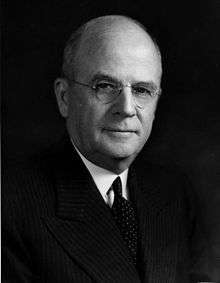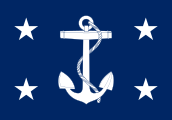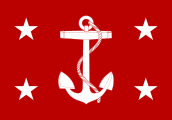Francis P. Matthews

Francis Patrick Matthews (March 15, 1887 – October 18, 1952) served as the 8th Supreme Knight of the Knights of Columbus from 1939 to 1945, the 49th United States Secretary of the Navy from 1949 to 1951, and the 8th United States Ambassador to Ireland from 1951 to 1952.
Biography
Born in Albion, Nebraska, Matthews spent most of his adult life in Omaha. He graduated from Creighton University in Omaha in 1913, then practiced law in that city from that time onward. He was active in business pursuits, civic and religious affairs and Democratic Party politics. From 1933 through 1949, he served as a consultant to the Reconstruction Finance Corporation.
During the Second World War, Mr. Matthews served as a Director and Vice President of the United Service Organizations (USO) and was also involved in war-relief work. He was Director (1941–1951) of the Department of Finance in the U.S. Chamber of Commerce. He also chaired their "Committee on Socialism and Communism."[1] Following the war, he served briefly (1946–1947) on the President's Committee on Civil Rights.
President Harry S. Truman tapped Matthews in early 1949 to become Secretary of the Navy when the previous Secretary of the Navy, John L. Sullivan, resigned in protest when Secretary of Defense Louis A. Johnson the canceled the heavy aircraft carrier USS United States.
Matthews entered the post in May 1949, at a time of internal turmoil in the Department of Defense resulting from significant funding reductions and controversial decisions on defense priorities. He served through the first year of the Korean War; during his two years in office, the federal government was massively increasing defense spending to meet international crises, and all the armed forces were under major strain as they simultaneously tried to meet the demands of a hot war in Asia and an intensive defense build-up in Europe.
One of the key events of Matthews' time at the Navy Department was the so-called "Revolt of the Admirals," an intense controversy between the Navy and the Air Force over funding. The Air Force wanted control of strategic nuclear bombing, and control of all aircraft as well. It argued that the Navy's carriers were obsolete, and the Air Force did not want the Navy to have its own "competing" air force. The Navy wanted to continue naval aviation, and wanted to build much larger carriers to handle the larger, heavier and more powerful jet aircraft. Such a carrier, the Navy argued, could also play a strategic role in nuclear deterrence. The flush-deck carriers planned (known as "supercarriers") were a forerunner of the modern nuclear carrier. The Air Force wanted funding to focus on the massive Convair B-36 bomber. Top Navy leaders publicly expressed their dissatisfaction with the Defense Departments plans and policies, and several senior admirals, including the Navy's top admiral, Louis E. Denfeld, Chief of Naval Operations, were forced by Matthews to resign, or did so in protest.
Matthew's perceived vindictiveness towards much of the Navy's uniformed senior leadership during his tenure led to a perception by both the public and the U.S Congress of the Navy's civilian leadership woes, a perception that also did not go totally unnoticed by the news media of the period. As The Washington Daily News reported at the time, "…Secretary of the Navy Matthews does not have the confidence of the Navy and can not win it...Moreover, Mr. Matthews has forfeited the confidence of Congress by firing Admiral Denfeld."[2]
Matthews resigned as Secretary of the Navy in July 1951 to become Ambassador to Ireland, the home of his ancestors.
He died on October 18, 1952 in Omaha, Nebraska.
References
 This article incorporates public domain material from websites or documents of the Naval History & Heritage Command.
This article incorporates public domain material from websites or documents of the Naval History & Heritage Command.
- ↑ Richard Gid Powers (1998). Not Without Honor: The History of American Anticommunism. Yale University Press. p. 197. ISBN 978-0-300-07470-3.
- ↑ Quoted in "Army and Navy Journal" 87, no. 10 (5 November 1949): 250.
- Wolk, Herman S. The Revolt of the Admirals." Air Force (May 1988): 73.5. Online. Air Force Association. Viewed 30 April 2005.
- Lewis, Andrew L., LCDR, USN. The Revolt of the Admirals (April 1998). Student paper from Air Command and Staff College, Air University, Maxwell Air Force Base, Alabama. Viewed 30 April 2005.
- Notes on Meeting with Representatives of Navy League of the United States in SECNAV's Office, 11 January 1950.
External links
- Matthews biography from the Naval Historical Center
- Profile of Matthews from the Truman Presidential Library
- Francis Patrick Matthews Memorial at Find A Grave
| Religious titles | ||
|---|---|---|
| Preceded by Martin H. Carmody |
Supreme Knight of the Knights of Columbus 1939–1945 |
Succeeded by John E. Swift |
| Government offices | ||
| Preceded by John L. Sullivan |
United States Secretary of the Navy May 25, 1949 – July 31, 1951 |
Succeeded by Dan A. Kimball |


